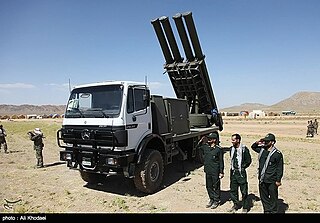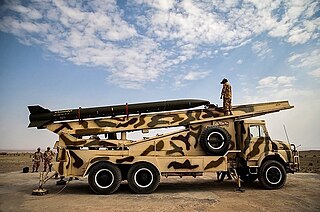Related Research Articles
The Joint Direct Attack Munition (JDAM) is a guidance kit that converts unguided bombs, or "dumb bombs", into all-weather precision-guided munitions (PGMs). JDAM-equipped bombs are guided by an integrated inertial guidance system coupled to a Global Positioning System (GPS) receiver, giving them a published range of up to 15 nautical miles (28 km). JDAM-equipped bombs range from 500 to 2,000 pounds. The JDAM's guidance system was jointly developed by the United States Air Force and United States Navy, hence the "joint" in JDAM. When installed on a bomb, the JDAM kit is given a GBU identifier, superseding the Mark 80 or BLU nomenclature of the bomb to which it is attached.

Israel Aerospace Industries, is Israel's major aerospace and aviation manufacturer, producing aerial and astronautic systems for both military and civilian usage. It has 14,000 employees as of 2021. IAI is state-owned by the government of Israel.

The Popeye is a family of air-to-surface missiles developed and in use by Israel, of which several types have been developed for Israeli and export users. A long-range submarine-launched cruise missile variant of the Popeye Turbo has been speculated as being employed in Israel's submarine-based nuclear forces. The United States operated the Popeye under a different designation according to US naming conventions as the AGM-142 Have Nap.

The Non-Line of Sight Launch System (NLOS-LS) was a self-contained missile launcher system that was under development by NETFIRES LLC, a partnership between Lockheed Martin and Raytheon. Each Container Launch Unit (CLU) holds 15 missiles, and a self-locating networked communications system. CLUs can be linked for coordinated launching, with the missiles fired and controlled remotely via autonomous vertical launch. The weapon is roughly 2 metres tall.

The Fajr-5 is an Iranian 333 mm long-range multiple launch rocket system (MLRS). The Fajr-5 was developed during the 1990s and has since been exported to various armed actors in the Middle East.
The GBU-44/B Viper Strike glide bomb was a GPS-aided laser-guided variant of the Northrop Grumman Brilliant Anti-Tank (BAT) munition which originally had a combination acoustic and infrared homing seeker. The system was initially intended for use from UAVs, and it was also integrated with the Lockheed AC-130 gunship, giving that aircraft a precision stand-off capability. The Viper Strike design is now owned by MBDA.

LORA is a theater quasi-ballistic missile developed by Israel Aerospace Industries (IAI).

The Weishi family of multiple rocket launcher systems were mainly developed by Sichuan Academy of Aerospace Technology in the central province of Sichuan, China at Chengdu city. The systems include the 302 mm (11.9 in) WS-1, the improved 302 mm (11.9 in) WS-1B, the 122 mm (4.8 in) WS-1E, the 400 mm (16 in) WS-2, as well as many other models. The WS-1 series weapon system did not enter PLA service and has order from Thailand. The WS-2 may finally see PLA service in the future. It's worth noticing that although sharing the same name, there are other developers for different models of Weishi series multiple rocket launchers (MRL) other than the primary developer SCAIC.

The Nimrod is a long-range air-to-surface missile developed by Israel Aerospace Industries. While designed for mainly anti-tank warfare, it provides standoff strike ability against a variety of point targets such as armoured personnel carriers (APCs), ships, bunkers, personnel concentrations, and guerrillas.
The A-100 is a 300 mm (12 in), 10-tube multiple rocket launcher developed by Beijing-based China Academy of Launch Vehicle Technology for the Chinese PLA ground forces. It is a derivative of Weishi Rockets WS-1 with simple cascade terminal inertial guidance.
The B-611 is a Chinese solid-fuelled short-range ballistic missile (SRBM) developed by China Precision Machinery Import-Export Corporation (CPMIEC). The missile has a maximum range of 150–400 km (93–249 mi).

A precision-guided munition (PGM), also called a smart weapon, smart munition, or smart bomb, is a guided munition intended to hit a specific target, to minimize collateral damage and increase lethality against intended targets. During the Persian Gulf War guided munitions accounted for only 9% of weapons fired, but accounted for 75% of all successful hits. Despite guided weapons generally being used on more difficult targets, they were still 35 times more likely to destroy their targets per weapon dropped.

The Griffin Laser Guided Bomb is a laser-guided bomb system made by Israel Aerospace Industries' MBT missile division. It is an add-on kit which is used to retrofit existing Mark 82, Mark 83, and Mark 84 and other unguided bombs, making them into laser-guided smart bombs. Initial development completed in 1990.

The Naze'at 6-H and Naze'at 10-H/Mushak-120/Iran-130 are two Iranian long-range artillery rockets with ranges of about 100 km. The Naze'at 10-H is larger, more powerful, and has a longer range than the Nazeat 6-H. Like Iran's similar shaped Zelzal rockets, Naze'at rockets do not have a guidance system. Both systems are also widely known without the -H suffix, as the Naze'at 6 and Naze'at 10. The Iranians also have developed another 500 kg version called the Mushak-160 with 160 km range.

Barak 8, also known as LR-SAM or MR-SAM, is an Indian-Israeli jointly developed surface-to-air missile (SAM) system, designed to defend against any type of airborne threat including aircraft, helicopters, anti-ship missiles, and UAVs as well as ballistic missiles, cruise missiles and combat jets. Both maritime and land-based variants of the system exist.

CM501G is a Chinese land attack missile first revealed during the 9th Zhuhai Airshow held in November 2012. Developed by China Aerospace Science and Industry Corporation (CASIC), CM-501G is also available in air and ship launched versions upon customers' requests, but only the land-based version made its public debut at the airshow.

The IAI Green Dragon is a loitering munition developed by the Israel Aerospace Industries. The drone is low cost that can loiter for 1.5 hours and a range of 40–50 km. It is munition itself with 3 kg warhead that can approach the target silently and hit with the effect of < 1m.
A loitering munition, also known as a suicide drone, kamikaze drone, or exploding drone, is a kind of aerial weapon with a built-in warhead that is typically designed to loiter around a target area until a target is located, then attack the target by crashing into it. Loitering munitions enable faster reaction times against hidden targets that emerge for short periods without placing high-value platforms near the target area and also allow more selective targeting as the attack can be changed mid-flight or aborted.
SkySniper is an air-to-surface missile developed by Israel Aerospace Industries IAI. The 4 metres (13 ft) long weapon has a maximum range of 81 nautical miles, and carries a general purpose blast/fragmentation warhead. The SkySniper uses GPS/INS guidance for targeting under all weather conditions. IAI designed the SkySniper for a maximum loadout of four missiles on contemporary combat aircraft such as the F-15, F/A-18, F-16, MiG-29, and Kfir.

The KAI LAH is a compact twin-engine combat helicopter that is being developed by Korea Aerospace Industries (KAI).
References
- ↑ "New tactical fighting tools on the ground and in the air". Archived from the original on 30 July 2013. Retrieved 22 January 2015.
- ↑ "Israel Unveils New Precision Weapon Systems for the Ground Forces". Archived from the original on 16 November 2017. Retrieved 5 December 2017.
- 1 2 "JUMPER". IAI . Retrieved 22 January 2015.
- ↑ "Israel Aerospace Industries to Present a Maritime Application for Its Autonomous Artillery System- Jumper at IMDEX, Singapore". IAI . Retrieved 22 January 2015.
- ↑ "IAI Unveils JUMPER Missile for Urban Warfare". Arutz Sheva. 4 September 2009. Retrieved 22 January 2015.